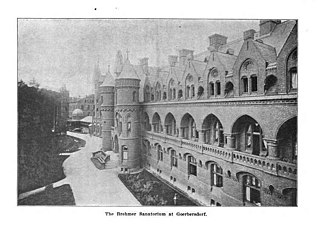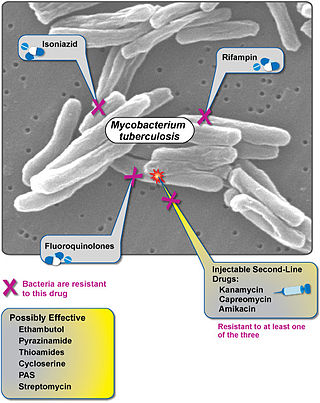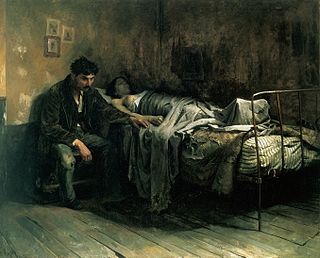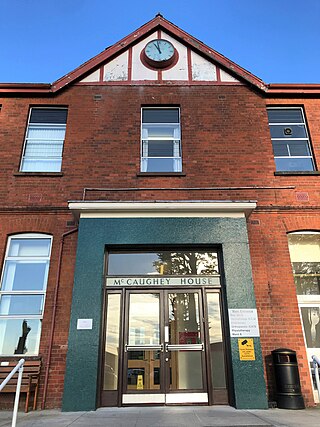Related Research Articles

Tuberculosis (TB) is an infectious disease usually caused by Mycobacterium tuberculosis (MTB) bacteria. Tuberculosis generally affects the lungs, but it can also affect other parts of the body. Most infections show no symptoms, in which case it is known as latent tuberculosis. Around 10% of latent infections progress to active disease which, if left untreated, kill about half of those affected. Typical symptoms of active TB are chronic cough with blood-containing mucus, fever, night sweats, and weight loss. It was historically referred to as consumption due to the weight loss associated with the disease. Infection of other organs can cause a wide range of symptoms.

Mitcham is an area within the London Borough of Merton in Southwest London, England. It is centred 7.2 miles (11.6 km) southwest of Charing Cross. Originally a village in the county of Surrey, today it is mainly a residential suburb, and includes Mitcham Common. It has been a settlement throughout recorded history.

A sanatorium, also sanitarium or sanitorium, are antiquated names for specialised hospitals, for the treatment of specific diseases, related ailments and convalescence. Sanatoriums are often in a healthy climate, usually in the countryside. The idea of healing was an important reason for the historical wave of establishments of sanatoriums, especially at the end of the 19th- and early 20th centuries. One sought, for instance, the healing of consumptives, especially tuberculosis or alcoholism, but also of more obscure addictions and longings of hysteria, masturbation, fatigue and emotional exhaustion. Facility operators were often charitable associations such as the Order of St. John and the newly founded social welfare insurance companies.

World Tuberculosis Day, observed on 24 March each year, is designed to build public awareness about the global epidemic of tuberculosis (TB) and efforts to eliminate the disease. In 2018, 10 million people fell ill with TB, and 1.5 million died from the disease, mostly in low and middle-income countries. This also makes it the leading cause of death from an infectious disease.

Back-to-backs are a form of terraced houses in the United Kingdom, built from the late 18th century through to the early 20th century in various guises. Many thousands of these dwellings were built during the Industrial Revolution for the rapidly increasing population of expanding factory towns. Back-to-backs share party walls on three of their four sides, with the front wall having the only door and windows.

Sunland Hospital refers to a chain of state schools located throughout the state of Florida. Originally named the W. T. Edwards Tuberculosis Hospitals, the facilities were later remodelled into "Sunland Centers" with services for the mentally and physically disabled, specializing mostly in children. A large majority of the centers were shut down by 1983 for various health and safety reasons.

Paimio Sanatorium is a former tuberculosis sanatorium in Paimio, Southwest Finland, designed by Finnish architect Alvar Aalto. Aalto received the design commission having won the architectural competition for the project held in 1929. The building was completed in 1933, and soon after received critical acclaim both in Finland and abroad. The building served exclusively as a tuberculosis sanatorium until the early 1960s, when it was converted into a general hospital. Today the building is owned by Turku University Hospital but is not functioning as a hospital; rather, the building has functioned as private rehabilitation center for children since 2014. The sanatorium has been nominated to become a UNESCO World Heritage Site.

Overcrowding or crowding is the condition where more people are located within a given space than is considered tolerable from a safety and health perspective. Safety and health perspectives depend on current environments and on local cultural norms. Overcrowding may arise temporarily or regularly, in the home, in public spaces or on public transport. Overcrowding in the home can cause particular concern, since the home is an individual's place of shelter.

Extensively drug-resistant tuberculosis (XDR-TB) is a form of tuberculosis caused by bacteria that are resistant to some of the most effective anti-TB drugs. XDR-TB strains have arisen after the mismanagement of individuals with multidrug-resistant TB (MDR-TB).

Tuberculosis is a serious public health problem in China. China has the world's third largest cases of tuberculosis, but progress in tuberculosis control was slow during the 1990s. Detection of tuberculosis had stagnated at around 30% of the estimated total of new cases, and multidrug-resistant tuberculosis was a major problem. These signs of inadequate tuberculosis control can be linked to a malfunctioning health system. The spread of severe acute respiratory syndrome (SARS) in 2003, brought to light substantial weaknesses in the country's public health system. After the government realized the impact that the SARS outbreak had on the country, they increased leadership in their health department. After the SARS epidemic was brought under control, the government increased its commitment and leadership to tackle public health problems and, among other efforts, increased public health funding, revised laws that concerned the control of infectious diseases, implemented the world's largest internet-based disease reporting system to improve transparency, reach and speed, and started a program to rebuild local public health facilities and national infrastructure.

Throughout history, the disease tuberculosis has been variously known as consumption, phthisis, and the White Plague. It is generally accepted that the causative agent, Mycobacterium tuberculosis originated from other, more primitive organisms of the same genus Mycobacterium. In 2014, results of a new DNA study of a tuberculosis genome reconstructed from remains in southern Peru suggest that human tuberculosis is less than 6,000 years old. Even if researchers theorise that humans first acquired it in Africa about 5,000 years ago, there is evidence that the first tuberculosis infection happened about 9,000 years ago. It spread to other humans along trade routes. It also spread to domesticated animals in Africa, such as goats and cows. Seals and sea lions that bred on African beaches are believed to have acquired the disease and carried it across the Atlantic to South America. Hunters would have been the first humans to contract the disease there.

Pukeora Sanatorium or Pukeora Tuberculosis Sanatorium was a tuberculosis (TB) hospital in the Hawke's Bay, New Zealand.
There are a number risk factors for tuberculosis infection; worldwide the most important of these is HIV. Co-infection with HIV is a particular problem in Sub-Saharan Africa, due to the high incidence of HIV in these countries. Smoking more than 20 cigarettes a day increases the risk of TB by two to four times while silicosis increases the risk about 30 fold. Diabetes mellitus is also an important risk factor that is growing in importance in developing countries. Other disease states that increase the risk of developing tuberculosis are Hodgkin lymphoma, end-stage renal disease, chronic lung disease, malnutrition, and alcoholism. A person's genetics also play a role.

Tuberculosis in India is a major health problem, causing about 220,000 deaths every year. In 2020, the Indian government made statements to eliminate tuberculosis from the country by 2025 through its National TB Elimination Program. Interventions in this program include major investment in health care, providing supplemental nutrition credit through the Nikshay Poshan Yojana, organizing a national epidemiological survey for tuberculosis, and organizing a national campaign to tie together the Indian government and private health infrastructure for the goal of eliminating the disease.

The Indian hospitals were racially segregated hospitals, originally serving as tuberculosis sanatoria but later operating as general hospitals for indigenous peoples in Canada which operated during the 20th century. The hospitals were originally used to isolate Indigenous tuberculosis patients from the general population because of a fear among health officials that "Indian TB" posed a danger to the non-indigenous population. Many of these hospitals were located on Indian reserves, and might also be called reserve hospitals, while others were in nearby cities.
The town of Colorado Springs, Colorado played an important role in the history of tuberculosis in the era before antituberculosis drugs and vaccines. Tuberculosis management before this era was difficult and often of limited effect. In the 19th century, a movement for tuberculosis treatment in hospital-like facilities called sanatoriums became prominent, especially in Europe and North America. Thus people sought tuberculosis treatment in Colorado Springs because of its dry climate and fresh mountain air. Some people stayed in boarding houses, while others sought the hospital-like facilities of sanatoriums. In the 1880s and 1890s, it is estimated that one-third of the people living in Colorado Springs had tuberculosis. The number of sanatoriums and hospitals increased into the twentieth century. During World War II, medicines were developed that successfully treated tuberculosis and by the late 1940s specialized tuberculosis treatment facilities were no longer needed.

The Oregon State Tuberculosis Hospital was a tuberculosis sanatorium in Salem, Oregon, United States. Established in 1905, it was the first public tuberculosis sanatorium on the West Coast. The main hospital building, constructed in 1894, had formerly housed the Oregon State Deaf-Mute School. After its conversion into the state tuberculosis hospital, multiple cottages and additional buildings were constructed on the property. The hospital remained in operation until 1969, when it was purchased by Corban University.

Whiteabbey Hospital is a hospital located close to the village of Whiteabbey, within the town of Newtownabbey, Northern Ireland. The hospital first opened in 1907 as The Abbey Sanitorium, centred around a country house known as 'The Abbey'. The house has stood on the site from 1850, and was once the residence of prominent architect Charles Lanyon. The hospital was extended and several buildings added throughout the early 20th century, and it was renamed Whiteabbey Hospital in 1947. The hospital is managed by the Northern Health and Social Care Trust. Many healthcare services have been withdrawn from the hospital, most recently with the closure of the Minor Injuries Unit in 2014.

Open-air treatment is the therapeutic use of fresh air and sunshine. In a hospital or sanitorium, this may be done by ensuring good ventilation in an airy, sunny room or by housing patients outdoors in tents or other open forms of accommodation. During the 20th century, such treatment was used for people with infectious respiratory diseases such as influenza or tuberculosis.

A tuberculosis hut or TB hut is a small wooden building that was used, mostly in the early twentieth century, by tuberculosis patients to recover in solitude.
References
- Mitcham News and Mercury, 20 November 1936
- T.Speake, The Housing of the Poor (London 1928)
- Robert Williams, The Face of the Poor (London 1897)
- 150 years of Promoting Public Health (RIPH 2006)
- Linda Bryder, Below the Magic Mountain: A Social History of Tuberculosis in Twentieth-Century Britain (OUP 1988)